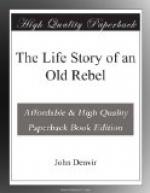He used to say that his father—the aforesaid Brian—had one of the largest noses in the country. There was only another man, he said, who could approach him in that respect. If the two men met in a very narrow “loanan “—what they call a “boreen” in other parts of Ireland—the other man, who was a bit of a wag, would put his hand to his nose, and make a motion of putting it aside, as if there was not sufficient room for two such organs, and call out with a kind of snuffle: “Pass, Brian!”
The late Mgr. O’Laverty, in his “History of the Dioceses of Down and Connor,” says: “From a government official survey in 1766 there were fifteen families in Castlewellan, of whom two only (Hagans and O’Donnells) were Catholics.” Up to that date there must have been, during this century, a considerable clearance of the Catholic population from the best land of this district, for I should say—judging from King James’s Army List and other authorities—that the Magennises (who, with the MacCartans, were the chief territorial families of the old race in Down) still held land in the neighbourhood up to the end of the seventeenth century. As still further showing this, it will be found that “Eiver Magennis of Castlewellan” was one of the members for the County Down in what Thomas Davis truly describes as “The Patriot Parliament” of 1689.
The learned historian of Down and Connor gives an interesting account of the only Norman colony of any extent in the province of Ulster. I have already spoken of this. Notwithstanding the very small Norman admixture, in the main the Catholics of the North are the most pure-blooded Celts in Ireland. And even in the case of Lecale, the original Celtic population intermingled with the descendants of the Norman settlers, who, like the older native population have ever remained true to the old faith. The preponderance of the Celtic element in the Catholics of Ulster must be overwhelming. What is called “Protestant Ulster” is practically a foreign importation, which the native population never absorbed, as they did the earlier invaders.
Speaking of the Rev. Cornelius (or, as he was oftener called, Corney) Denvir, a relative of ours, who afterwards became Bishop of Down and Connor, Father O’Laverty says: “The Denvirs are a Norman race, brought to Lecale by De Courcy. The late bishop observed the name in several of the towns in Normandy.”
I only met Bishop Denvir once, when my father—who was his second cousin—took me to see him at the Grecian Hotel, Liverpool, when he was on his way either to or from Rome. I once, when a small boy, incurred my father’s displeasure by criticising adversely (from what I had read in the “Nation”) Dr. Denvir’s support of what was called the “Bequest Bill.” There were some strictures in the “Nation” on the favour shown to this Bill by three of the Irish Hierarchy, Archbishops Crolly and Murray, and Bishop Denvir. The last was a man of great learning. An edition of the Bible was published under his auspices by Sims and McIntyre, of Belfast.




